Related Research Articles

Alan Mathison Turing was an English mathematician, computer scientist, logician, cryptanalyst, philosopher and theoretical biologist. Turing was highly influential in the development of theoretical computer science, providing a formalisation of the concepts of algorithm and computation with the Turing machine, which can be considered a model of a general-purpose computer. He is widely considered to be the father of theoretical computer science and artificial intelligence.

Colossus was a set of computers developed by British codebreakers in the years 1943–1945 to help in the cryptanalysis of the Lorenz cipher. Colossus used thermionic valves to perform Boolean and counting operations. Colossus is thus regarded as the world's first programmable, electronic, digital computer, although it was programmed by switches and plugs and not by a stored program.

The Electronic Delay Storage Automatic Calculator (EDSAC) was an early British computer. Inspired by John von Neumann's seminal First Draft of a Report on the EDVAC, the machine was constructed by Maurice Wilkes and his team at the University of Cambridge Mathematical Laboratory in England. EDSAC was the second electronic digital stored-program computer to go into regular service.

The history of computing hardware covers the developments from early simple devices to aid calculation to modern day computers.
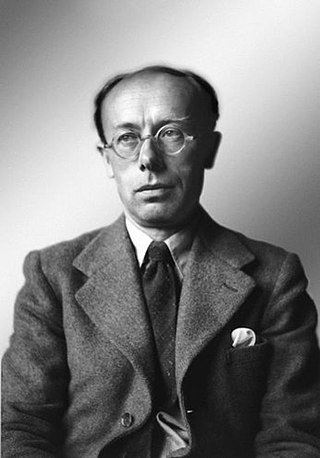
Maxwell Herman Alexander Newman, FRS,, generally known as Max Newman, was a British mathematician and codebreaker. His work in World War II led to the construction of Colossus, the world's first operational, programmable electronic computer, and he established the Royal Society Computing Machine Laboratory at the University of Manchester, which produced the world's first working, stored-program electronic computer in 1948, the Manchester Baby.
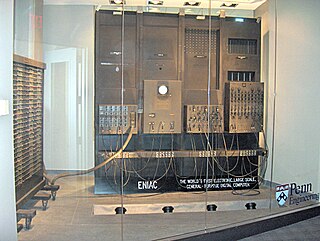
ENIAC was the first programmable, electronic, general-purpose digital computer, completed in 1945. There were other computers that had combinations of these features, but the ENIAC had all of them in one computer. It was Turing-complete and able to solve "a large class of numerical problems" through reprogramming.
A stored-program computer is a computer that stores program instructions in electronically or optically accessible memory. This contrasts with systems that stored the program instructions with plugboards or similar mechanisms.

Argonne National Laboratory is a federally funded research and development center in Lemont, Illinois, United States. Founded in 1946, the laboratory is owned by the United States Department of Energy and administered by UChicago Argonne LLC of the University of Chicago. The facility is the largest national laboratory in the Midwest.

Sir Maurice Vincent Wilkes was an English computer scientist who designed and helped build the Electronic Delay Storage Automatic Calculator (EDSAC), one of the earliest stored program computers, and who invented microprogramming, a method for using stored-program logic to operate the control unit of a central processing unit's circuits. At the time of his death, Wilkes was an Emeritus Professor at the University of Cambridge.
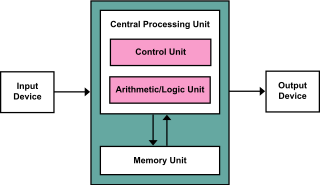
The von Neumann architecture—also known as the von Neumann model or Princeton architecture—is a computer architecture based on a 1945 description by John von Neumann, and by others, in the First Draft of a Report on the EDVAC. The document describes a design architecture for an electronic digital computer with these components:

The Manchester Baby, also called the Small-Scale Experimental Machine (SSEM), was the first electronic stored-program computer. It was built at the University of Manchester by Frederic C. Williams, Tom Kilburn, and Geoff Tootill, and ran its first program on 21 June 1948.

The Department of Computer Science and Technology, formerly the Computer Laboratory, is the computer science department of the University of Cambridge. As of 2023 it employed 56 faculty members, 45 support staff, 105 research staff, and about 205 research students. The current Head of Department is Professor Alastair Beresford.

Jack Joseph Dongarra is an American computer scientist and mathematician. He is the American University Distinguished Professor of Computer Science in the Electrical Engineering and Computer Science Department at the University of Tennessee. He holds the position of a Distinguished Research Staff member in the Computer Science and Mathematics Division at Oak Ridge National Laboratory, Turing Fellowship in the School of Mathematics at the University of Manchester, and is an adjunct professor and teacher in the Computer Science Department at Rice University. He served as a faculty fellow at the Texas A&M University Institute for Advanced Study (2014–2018). Dongarra is the founding director of the Innovative Computing Laboratory at the University of Tennessee. He was the recipient of the Turing Award in 2021.

Tom Kilburn was an English mathematician and computer scientist. Over his 30-year career, he was involved in the development of five computers of great historical significance. With Freddie Williams he worked on the Williams–Kilburn tube and the world's first electronic stored-program computer, the Manchester Baby, while working at the University of Manchester. His work propelled Manchester and Britain into the forefront of the emerging field of computer science.
Douglas Rayner Hartree was an English mathematician and physicist most famous for the development of numerical analysis and its application to the Hartree–Fock equations of atomic physics and the construction of a differential analyser using Meccano.
Theory and Techniques for Design of Electronic Digital Computers was a course in the construction of electronic digital computers held at the University of Pennsylvania's Moore School of Electrical Engineering between July 8, 1946, and August 30, 1946, and was the first time any computer topics had ever been taught to an assemblage of people. The course disseminated the ideas developed for the EDVAC and initiated an explosion of computer construction activity in the United States and internationally, especially in the United Kingdom.

The Manchester Mark 1 was one of the earliest stored-program computers, developed at the Victoria University of Manchester, England from the Manchester Baby. Work began in August 1948, and the first version was operational by April 1949; a program written to search for Mersenne primes ran error-free for nine hours on the night of 16/17 June 1949.
Kathleen Hylda Valerie Booth was a British computer scientist and mathematician who wrote the first assembly language and designed the assembler and autocode for the first computer systems at Birkbeck College, University of London. She helped design three different machines including the ARC, SEC, and APE(X)C.
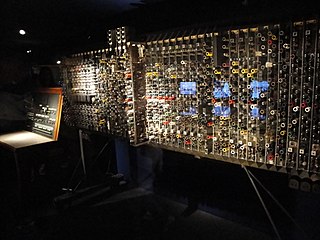
Michael Woodger is a pioneering English computer scientist. He was influential in the development of the early Pilot ACE computer, working with Alan Turing, and later the design and documentation of programming languages such as ALGOL 60 and Ada. He was based at the National Physical Laboratory (NPL) located in Teddington, London, for most of his career.
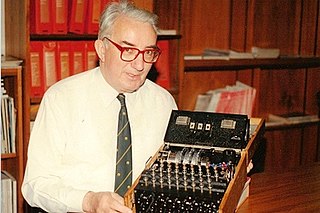
Robert Francis Churchhouse CBE KSG, also known as Bob Churchhouse was Professor of Computing Mathematics at Cardiff University and President of the Institute of Mathematics and its Applications.
References
- ↑ "Max Newman and the Mark 1". Archived from the original on 11 May 2008. Retrieved 30 January 2010.
- ↑ "The Modern History of Computing" . Retrieved 30 January 2010.
- ↑ Copeland, B. Jack (9 September 2004). The essential Turing: seminal writings in computing, logic, philosophy . Clarendon Press. p. 209. ISBN 9780191520280 . Retrieved 27 January 2010.